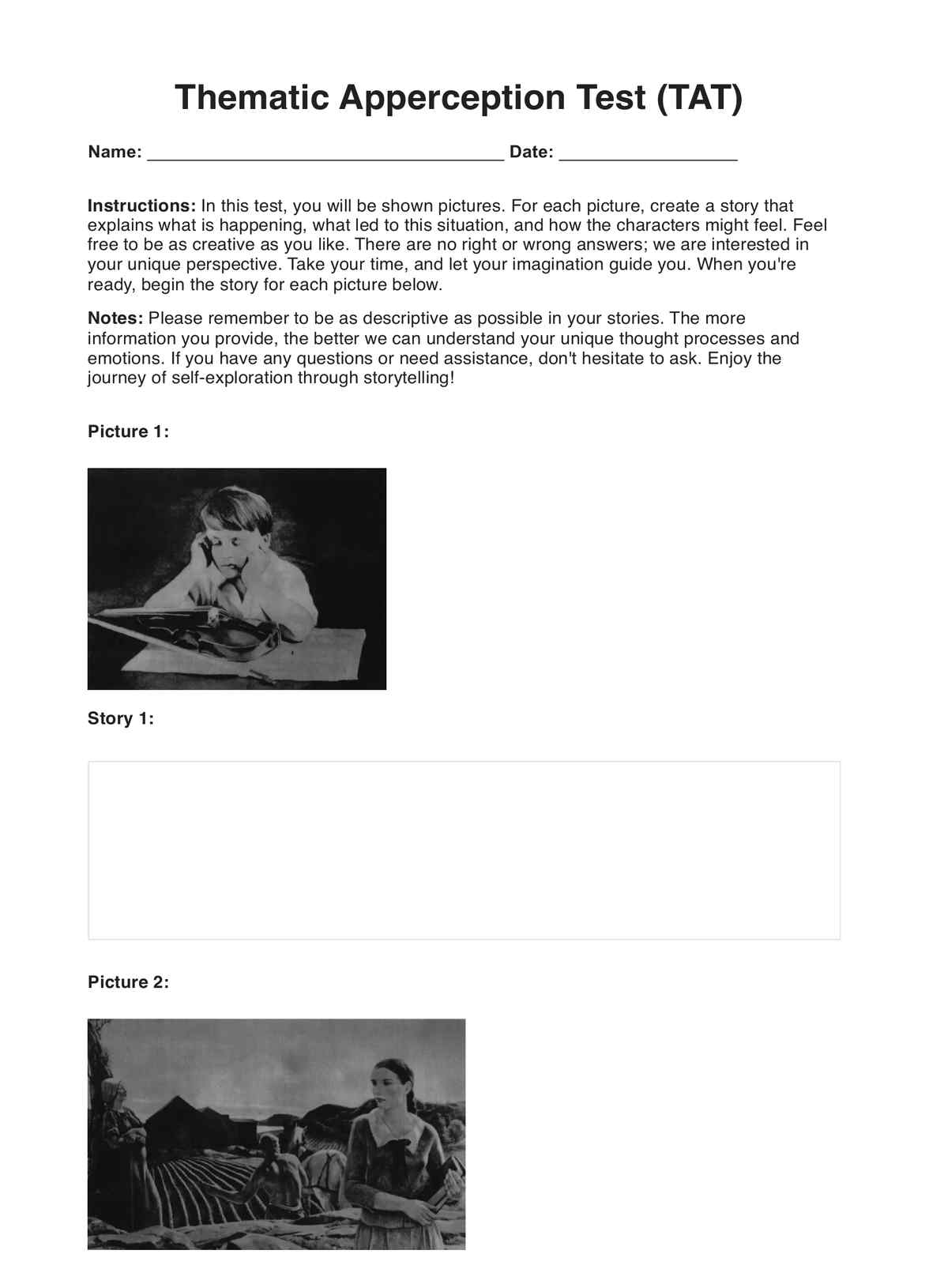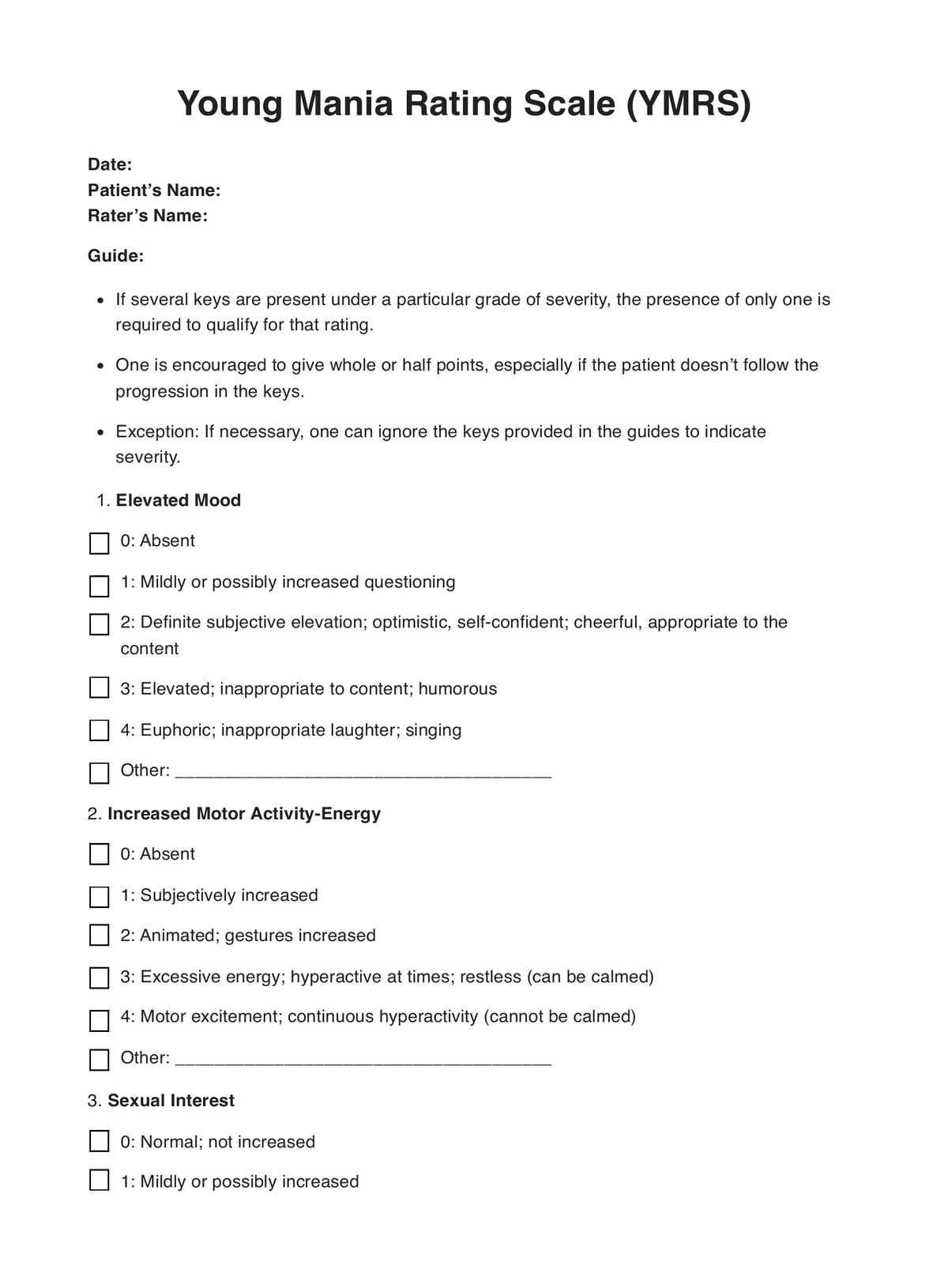Trauma questionnaire
Looking for a trauma questionnaire? Find a free PDF download here to help assess and understand trauma-related symptoms in individuals.


Clinical overview: what is a Trauma Questionnaire?
A trauma questionnaire is a specialized tool designed to assess and evaluate an individual's exposure to traumatic events and the resulting psychological impact. These questionnaires are pivotal in mental health and psychology, serving as valuable instruments for clinicians, researchers, and professionals.
The primary objective of a trauma questionnaire is to gather detailed information about a person's experiences, allowing professionals to understand better and address the effects of trauma on their mental well-being.
Trauma questionnaires play a crucial role in identifying various types of trauma, ranging from acute incidents to chronic exposure, childhood trauma, and assessing their impact on an individual's mental health.
These questionnaires also aid in the early detection of trauma-related disorders, such as post-traumatic stress disorder (PTSD), allowing for timely and appropriate interventions for trauma responses.
A well-constructed trauma questionnaire typically includes questions about the nature and timing of traumatic events, the individual's emotional responses, and the ongoing impact on their daily life.
Questions may cover a range of experiences, including but not limited to accidents, violence, abuse, or natural disasters. The responses provide valuable insights into the individual's coping mechanisms, resilience, and specific areas that may require therapeutic attention.
One of the strengths of trauma questionnaires lies in their adaptability to diverse populations and various forms of trauma. Professionals can customize these tools to suit specific demographics, cultural contexts, or the nature of the traumatic events under consideration. This flexibility ensures that the assessment is accurate and sensitive to the unique needs of each individual.
Trauma questionnaire Template
Trauma questionnaire Example
Understanding trauma symptoms
Trauma symptoms can manifest in various ways, impacting an individual's emotional, psychological, and physical well-being. Recognizing these symptoms is crucial for both individuals and professionals to initiate appropriate support and intervention. Here, we delve into key trauma symptoms categorized for better understanding.
Re-experiencing symptoms
- Flashbacks: Individuals may involuntarily re-live traumatic events, experiencing vivid and distressing memories.
- Nightmares: Trauma often intrudes into sleep, causing distressing and vivid nightmares related to the traumatic experience.
- Intrusive Thoughts: Persistent and distressing thoughts about the trauma may intrude into daily life, causing significant distress.
Avoidance and numbing
- Avoidance: Individuals may actively avoid people, places, or activities that trigger trauma memories.
- Emotional numbing: A sense of emotional detachment or numbing can occur, reducing the ability to experience pleasure or connect with others.
- Loss of Interest: Individuals may lose interest in activities they once enjoyed, as the trauma affects their capacity for joy and engagement.
Hyperarousal symptoms
- Hypervigilance: A heightened state of alertness, constantly scanning the environment for potential threats.
- Irritability: Individuals may experience increased irritability or have difficulty controlling their temper.
- Difficulty concentrating: Trauma can impact cognitive function, leading to difficulty focusing and completing tasks.
- Negative changes in thinking and mood: People who have gone through a lot of traumatic life events often think negatively of themselves and their life. This leads to low moods and mood swings as well.
- Negative Beliefs: Individuals may develop negative beliefs about themselves, others, or the world due to the trauma.
- Persistent sadness: A pervasive and prolonged sadness or hopelessness may accompany trauma.
Feelings of Detachment: Individuals may feel emotionally detached from others, leading to challenges in forming or maintaining relationships.
How is trauma diagnosed?
Diagnosing trauma involves a comprehensive assessment of an individual's experiences, symptoms, and overall well-being. Mental health professionals use established criteria and assessment tools to determine whether an individual may be experiencing trauma-related disorders.
One key diagnosis associated with trauma is posttraumatic Stress Disorder (PTSD), which is recognized globally as a significant mental health concern.
Posttraumatic stress disorder (PTSD)
PTSD is a specific diagnosis that encompasses a range of symptoms resulting from exposure to traumatic events. To diagnose PTSD, mental health professionals follow criteria outlined in the Diagnostic and Statistical Manual of Mental Disorders (DSM-5), a widely accepted guide for mental health diagnoses.
The manual outlines specific criteria, including re-experiencing symptoms, avoidance and numbing, and hyperarousal symptoms.
International Trauma Questionnaire
The International Trauma Questionnaire (ITQ) is a valuable tool used in the diagnostic process. It is a self-report measure designed to assess the symptoms of PTSD and Complex PTSD (C-PTSD).
C-PTSD is a diagnosis that is considered when individuals have experienced prolonged or repeated trauma, often involving interpersonal relationships.
Factors leading to diagnosis
Several factors contribute to the diagnosis of trauma-related disorders:
- Exposure to Traumatic Events: The individual must have been exposed to a traumatic event, as defined by the DSM-5 criteria.
- Symptom Duration: Symptoms persisting for more than one month and causing significant distress or functional impairment are considered for diagnosis.
- Self-Report Measures: Mental health professionals often use self-report measures like the ITQ to gather information directly from individuals about their experiences and symptoms.
- Functional Impairment: The impact of trauma on an individual's daily functioning is a critical consideration for diagnosis. Functional impairment may manifest in various areas, such as work, relationships, and overall quality of life.
How does this trauma questionnaire work?
Trauma questionnaires, such as the International Trauma Questionnaire (ITQ), are essential tools in assessing and understanding the impact of traumatic experiences on an individual's mental health.
These questionnaires follow a systematic approach to gather information related to PTSD and Complex PTSD symptoms, helping mental health professionals make accurate diagnoses and tailor effective interventions.
Here is how you can use a trauma questionnaire to make it work effectively:
Introduction to Traumatic Exposure:
The questionnaire typically begins with an introduction informing respondents about the assessment's purpose. It may ask individuals to provide information about their history of traumatic exposure, ensuring a comprehensive understanding of their experiences.
Assessment of PTSD symptoms
Specific sections of the questionnaire focus on the core symptom clusters of PTSD, as outlined in the DSM-5. Respondents are asked to reflect on their experiences of re-experiencing, avoidance, and hyperarousal symptoms, providing valuable insights into the presence and severity of PTSD symptoms.
Identification of complex PTSD symptoms
For individuals who have experienced prolonged or repeated trauma, the questionnaire assesses symptoms associated with Complex PTSD (C-PTSD). This includes evaluating affective dysregulation, disturbances in self-identity, and challenges in forming and maintaining relationships.
Functional impairment assessment
To understand the real-world impact of trauma, the questionnaire explores areas of functional impairment. Questions may address difficulties in work, relationships, and daily life, providing a comprehensive view of the individual's overall well-being.
Scoring and interpretation
Mental health professionals use scoring systems to interpret the responses and determine the severity of symptoms. The assessment helps in identifying the presence of PTSD or C-PTSD and gauges the degree of functional impairment.
Tailoring interventions
The information gathered from the questionnaire guides mental health professionals in tailoring interventions. Whether it's traditional therapeutic approaches, medication, or a combination, the assessment informs a comprehensive treatment plan aligned with the individual's unique needs.
Interpreting the results: next steps
After completing a trauma questionnaire, understanding and interpreting the results are crucial for guiding further action. This helps professionals to assess traumatic exposure, symptom clusters, and see how traumatic life events have affected the patient overall.
Here's a breakdown of common results and their implications:
Assessed traumatic exposure
If the questionnaire reveals a history of traumatic exposure, it signifies that the individual has experienced events that may have lasting psychological effects. This result underscores the importance of exploring these events' specific nature and impact in subsequent discussions and therapeutic interventions.
Negative self-concept
A negative self-concept, as indicated by responses to certain questionnaire items, suggests that individuals may hold unfavorable beliefs about themselves stemming from traumatic experiences.
Addressing and challenging these negative self-perceptions becomes a focal point in therapeutic interventions promoting positive self-esteem and resilience.
Self-report measure for PTSD
If the questionnaire indicates a likelihood of meeting the criteria for Posttraumatic Stress Disorder (PTSD), it's essential to recognize the presence of symptoms across re-experiencing, avoidance, and hyperarousal clusters. This result prompts the need for a more in-depth clinical assessment to determine the severity and impact of disorder PTSD and complex negative alterations on the individual's life.
Symptom clusters
The identification of symptom clusters associated with anxiety disorders, particularly those aligned with PTSD, informs the choice of therapeutic interventions. Understanding whether re-experiencing, avoidance, or hyperarousal symptoms predominate helps tailor treatment strategies for optimal effectiveness.
Anxiety disorders
Results suggesting the presence of anxiety disorders, often comorbid with trauma-related conditions, highlight the need for a comprehensive treatment approach. Therapeutic interventions may include techniques to manage anxiety symptoms and enhance overall well-being.
Tips for managing the impacts of trauma
Trauma can have profound and lasting effects on mental well-being. Managing the impacts requires a thoughtful and comprehensive approach. Here are key tips for navigating the challenges associated with trauma:
Utilize self-report measures
In the aftermath of trauma, utilizing self-report measures, such as the International Trauma Questionnaire (ITQ), can provide a structured means of assessing and understanding the impact of traumatic stress. Regularly completing these measures can help individuals and clinicians track changes, identify patterns, and inform the ongoing management of symptoms.
Address negative alterations in mood and cognition
Negative alterations in mood and cognition are common after experiencing trauma. It's crucial to address these changes through therapeutic interventions that focus on reframing negative thought patterns and promoting a more positive and adaptive mindset. Cognitive-behavioral therapy (CBT) and other evidence-based approaches can be effective in this regard.
Tailor strategies for children and adolescents
Children and adolescents may experience trauma differently than adults. Tailoring strategies to their developmental needs is essential. Create a safe and supportive environment for open communication, encourage the expression of feelings through age-appropriate outlets, and involve caregivers in the healing process.
Holistic approach to traumatic stress
Managing the impacts of traumatic stress requires a holistic approach. This encompasses not only psychological interventions but also physical well-being. Regular exercise, a balanced diet, and sufficient sleep contribute to overall resilience and can positively influence mental health outcomes.
Seek professional support for PTSD
For those experiencing symptoms consistent with Posttraumatic Stress Disorder (PTSD), seeking professional support is crucial. Evidence-based treatments, including psychotherapy (such as trauma-focused therapy) and, in some cases, medication, can significantly improve symptoms and enhance overall well-being.
Different trauma assessments
Various trauma assessments are available, each serving specific purposes in evaluating the impact of traumatic experiences on individuals. Here are different types of trauma assessments:
Self-report measures
Self-report measures involve individuals providing subjective information about their experiences, symptoms, and well-being. These assessments often include questionnaires or surveys that individuals complete themselves.
The advantage of self-report measures is that they offer direct insight into the individual's perspective, including their perception of traumatic exposure, negative self-concept, and potential symptoms of Posttraumatic Stress Disorder (PTSD).
Structured clinical interviews
Structured clinical interviews are conducted by trained mental health professionals and follow a predetermined set of questions. These interviews allow clinicians to gather detailed information about an individual's trauma history, symptoms, and functioning. While they may be more time-consuming than self-report measures, structured clinical interviews comprehensively understand the individual's experiences.
Observational assessments
Observational assessments involve directly observing an individual's behavior, emotional responses, and interactions. These assessments are particularly useful when individuals have difficulty verbally expressing their experiences.
Additionally, observational assessments can provide valuable insights into the impact of trauma on daily functioning.
Behavioral assessments
Behavioral assessments focus on observing and measuring specific behaviors associated with trauma. This can include behavioral indicators of anxiety, avoidance, or hyperarousal. Behavioral assessments are often used with other assessment methods to paint a more complete picture of the individual's experience.
Psychophysiological assessments
Psychophysiological assessments measure physiological responses, such as heart rate, skin conductance, or brain activity, in response to trauma-related stimuli.
These assessments provide objective data about the individual's physiological reactions, offering additional insights into the neurobiological aspects of trauma.
Commonly asked questions
The trauma questionnaire is a structured tool designed to assess an individual's exposure to traumatic events and the resulting psychological impact. It serves as a valuable resource for mental health professionals to understand, evaluate, and address the effects of trauma on an individual's well-being.
The best assessment tool for trauma often depends on the specific needs of the individual and the goals of the evaluation. Self-report measures, like the International Trauma Questionnaire, are widely used, providing valuable insights into traumatic exposure and its psychological impact.


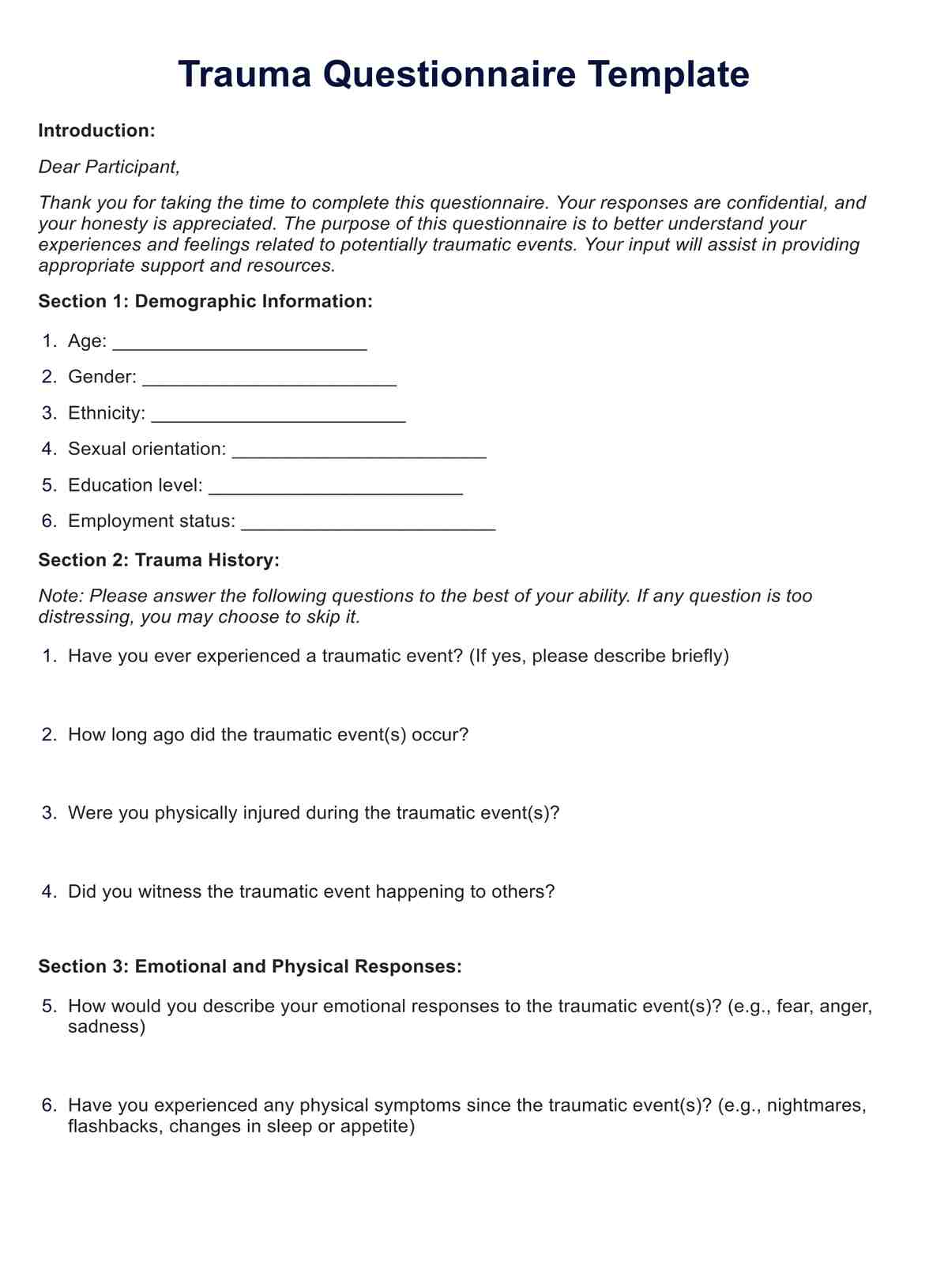
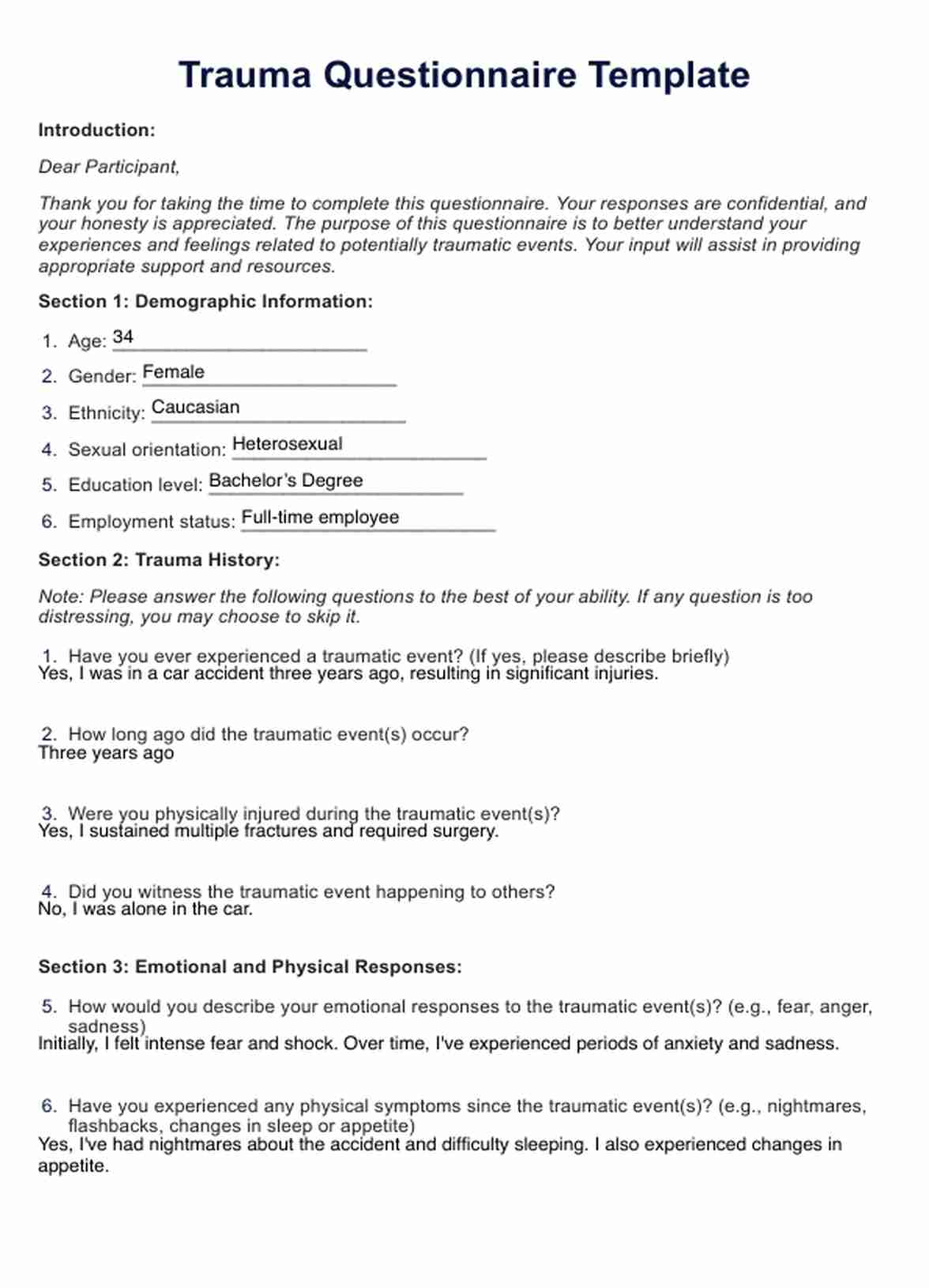

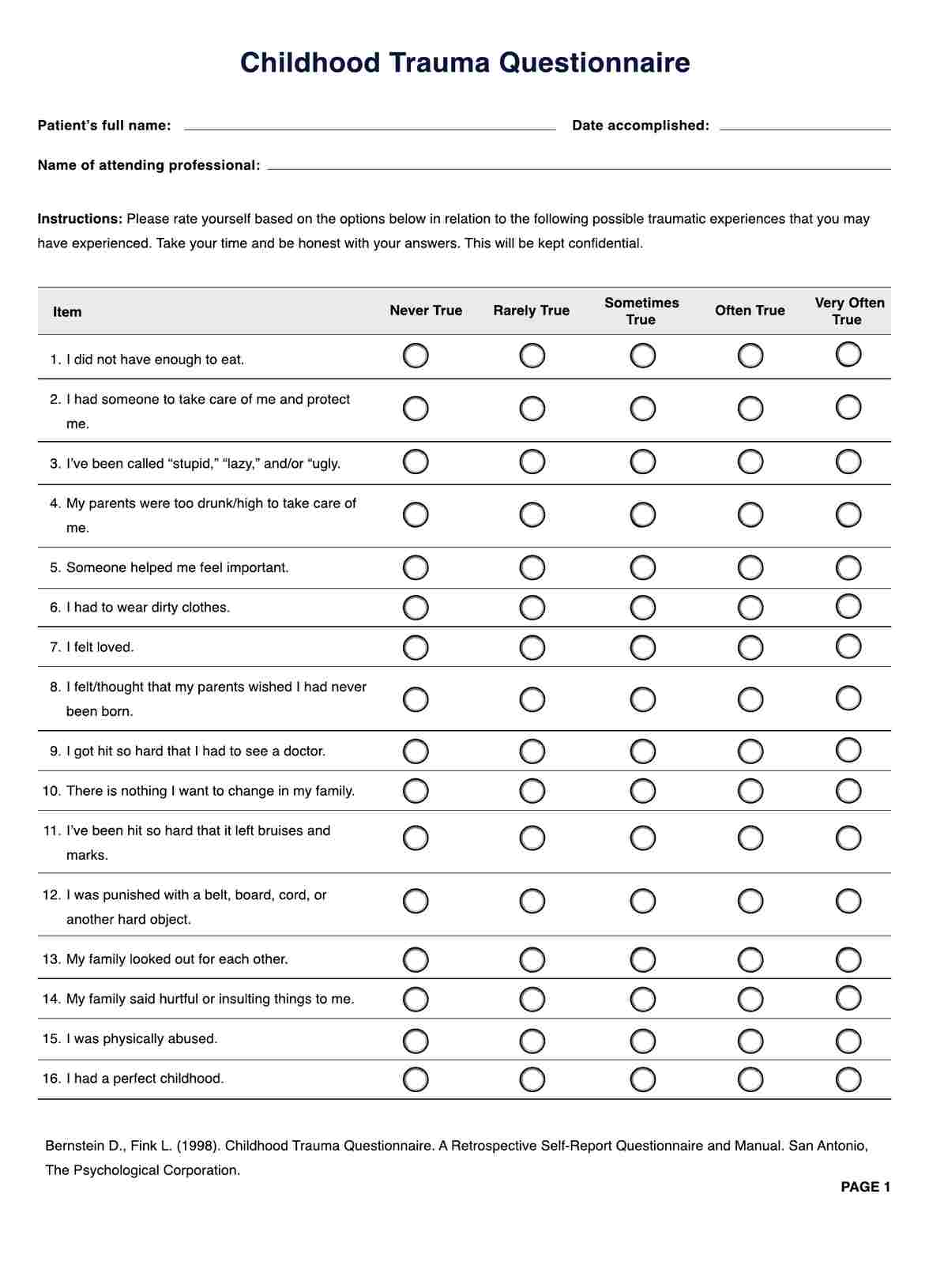
















-template.jpg)


























































































